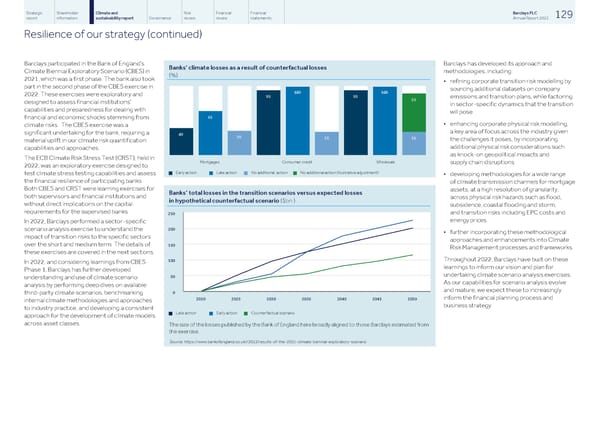Strategic Shareholder Climate and Risk Financial Financial Barclays PLC 129 report information sustainability report Governance review review statements Annual Report 2022 Resilience of our strategy (continued) Barclays participated in the Bank of England’s Barclays has developed its approach and Banks' climate losses as a result of counterfactual losses Climate Biennial Exploratory Scenario (CBES) in methodologies, including: (%) 2021, which was a first phase. The bank also took • refining corporate transition risk modelling by part in the second phase of the CBES exercise in sourcing additional datasets on company 60 35 64 100 65 100 — — 2022. These exercises were exploratory and 95 95 emissions and transition plans, while factoring 55 designed to assess financial institutions' in sector-specific dynamics that the transition capabilities and preparedness for dealing with will pose 65 financial and economic shocks stemming from • enhancing corporate physical risk modelling, climate risks. The CBES exercise was a a key area of focus across the industry given significant undertaking for the bank, requiring a 40 36 35 35 the challenges it poses, by incorporating material uplift in our climate risk quantification additional physical risk considerations such capabilities and approaches. as knock-on geopolitical impacts and The ECB Climate Risk Stress Test (CRST), held in Mortgages Consumer credit Wholesale supply chain disruptions 2022, was an exploratory exercise designed to Early action Late action No additional action No additional action (illustrative adjustment) test climate stress testing capabilities and assess n n n n • developing methodologies for a wide range the financial resilience of participating banks. of climate transmission channels for mortgage Both CBES and CRST were learning exercises for assets, at a high resolution of granularity, Banks’ total losses in the transition scenarios versus expected losses both supervisors and financial institutions and across physical risk hazards such as flood, in hypothetical counterfactual scenario ($bn ) without direct implications on the capital subsidence, coastal flooding and storm, requirements for the supervised banks. and transition risks including EPC costs and 250 energy prices In 2022, Barclays performed a sector-specific 200 scenario analysis exercise to understand the • further incorporating these methodological impact of transition risks to the specific sectors approaches and enhancements into Climate over the short and medium term. The details of 150 Risk Management processes and frameworks. these exercises are covered in the next sections. Throughout 2022, Barclays have built on these 100 In 2022, and considering learnings from CBES learnings to inform our vision and plan for Phase 1, Barclays has further developed undertaking climate scenario analysis exercises. 50 understanding and use of climate scenario As our capabilities for scenario analysis evolve analysis by performing deep dives on available and mature, we expect these to increasingly 0 third-party climate scenarios, benchmarking inform the financial planning process and 2020 2025 2030 2035 2040 2045 2050 internal climate methodologies and approaches business strategy. to industry practice, and developing a consistent Late action Early action Counterfactual scenario n n n approach for the development of climate models across asset classes. The size of the losses published by the Bank of England here broadly aligned to those Barclays estimated from the exercise. Source: https://www.bankofengland.co.uk//2022/results-of-the-2021-climate-biennial-exploratory-scenario
 Barclays PLC - Annual Report - 2022 Page 130 Page 132
Barclays PLC - Annual Report - 2022 Page 130 Page 132